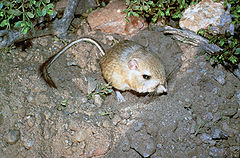- Giant Kangaroo Rat
-
Dipodomys ingens
Giant Kangaroo Rat
Conservation status Scientific classification Kingdom: Animalia Phylum: Chordata Class: Mammalia Subclass: Eutheria Order: Rodentia Family: Heteromyidae Genus: Dipodomys Species: D. ingens Binomial name Dipodomys ingens
(Merriam, 1904)The Giant Kangaroo Rat, Dipodomys ingens, is an endangered rodent species endemic to California.[1]
Contents
Description
Dipodomys ingens, the Giant Kangaroo Rat, is one of over 20 species of kangaroo rats, which are small members of the rodent family. The Giant Kangaroo Rat is the largest of the kangaroo rats, measuring about 15 cm (6 in.) in length, not including its long, tufted tail. It is tan or brown in color. Like other kangaroo rats it has a large head and large eyes, and long, strong hind legs with which it can hop at high speeds.
Habitat
The Giant Kangaroo Rat lives on dry, sandy grasslands and digs burrows in loose soil. It lives in colonies, and the individuals communicate with each other by drumming their feet on the ground. These foot thumping signals range from single, short thumps to long, drawn out “footrolls” that can average over 100 drums at 18 drums per second. These audible signals serve both as a warning of approaching danger, as a territorial communication, and to communicate mating status.
In the spring and summer, individuals generally spend less than two hours of the night foraging above ground. They are very territorial and never leave their den for more than 15 minutes per day. The Giant Kangaroo Rat then stores the seeds in a larder for later eating and gives birth to a litter of 1 to 7 babies, with an average of 3 per litter. It communicates with potential mates by sandbathing, where the Giant Kangaroo Rat rubs its sides in sand, leaving behind a scent to attract mates. They live for only 2–4 years.
This species was declared endangered on both the federal and California state levels in the 1980s. It inhabits less than a mere 2% of its original range and can now be found only in isolated areas west of the San Joaquin Valley, including the Carrizo Plain, the Elkhorn Plain, and the Kettleman Hills. The Giant Kangaroo Rat, like many other rodent species, lost much of its habitat as the Central Valley fell under agricultural use. Much information still needs to be obtained regarding their basic biology and compatibility with various land uses before clear directives can be made. Besides some projects currently underway in the Carrizo Plain National Monument, studies need to be conducted on populations whose range overlaps with private lands. According to information vetted by Los Padres Forest Watch, the GKR is a keystone species in the Carrizo Plain and probably elsewhere in the San Joaquin Valley. It provides food for predators and creates burrow systems used by other animals. It is important to recognize that GKR viability is not simply a matter of one obscure species, at all, but rather an integral cornerstone[citation needed] of the entire affected ecosystem. In the Carrizzo Plain, just outside the National Monument, GKR is in jeopardy due to several proposed massive solar installations as well as a mining proposal linked to the CVSR project[citation needed].
References
- ^ a b Linzey, A.V. & NatureServe (Williams, D.F. & Hammerson, G.) (2008). Dipodomys ingens. In: IUCN 2008. IUCN Red List of Threatened Species. Downloaded on 13 January 2009.
REFERENCE the
External links
Kingdom: Animalia · Phylum: Chordata · Class: Mammalia · Order: Rodentia · Superfamily: Geomyoidea Dipodomys
(Kangaroo rats)Agile Kangaroo Rat (Dipodomys agilis) · California Kangaroo Rat (Dipodomys californicus) · Gulf Coast Kangaroo Rat (Dipodomys compactus) · Desert Kangaroo Rat (Dipodomys deserti) · Texas Kangaroo Rat (Dipodomys elator) · Dipodomys phillipsii · Phillips's Kangaroo Rat (Dipodomys spectabilis) · Stephens' Kangaroo Rat (Dipodomys stephensi) · Narrow-faced Kangaroo Rat (Dipodomys venustus)Microdipodops
(Kangaroo mice)Category Categories:- IUCN Red List endangered species
- Dipodomys
- Endemic fauna of California
- Mammals of the United States
- San Joaquin Valley
Wikimedia Foundation. 2010.

